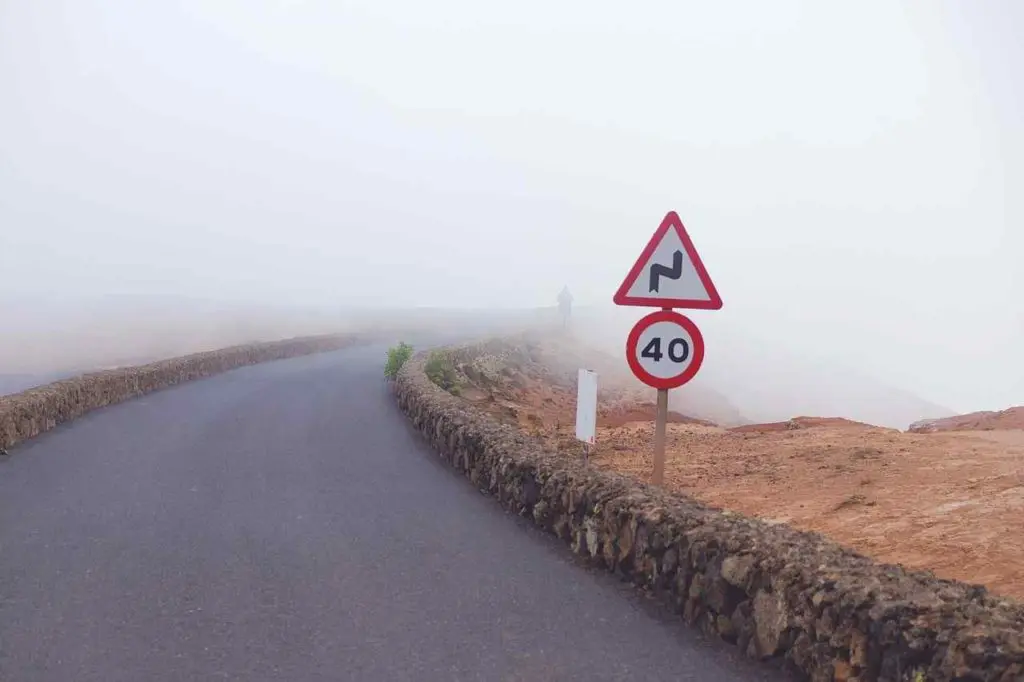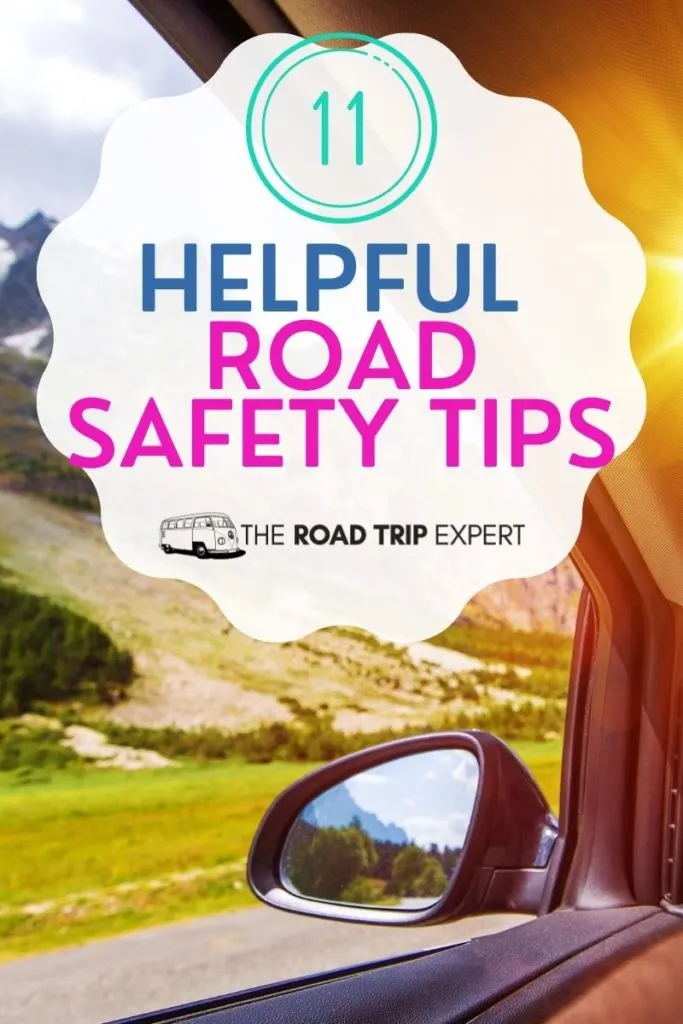Are you looking for some helpful road safety tips for drivers?
You’re not alone. Safe driving practices can really help prevent a collision – the impact of which could be nothing less than devastating.
At the very least, you could cause damage to your vehicle and cause financial distress. However, in many cases, a collision results in serious injuries, even fatally serious injuries.
In this article, we’re going to take a look at 11 helpful road safety tips that every driver can use, so you can feel secure behind the wheel on your next drive.
Don’t take any chances, read ahead, and make sure that you follow all of these road trip safety tips.
Affiliate Disclosure: Thank you for supporting The Road Trip Expert. When you purchase through links on this site, we may earn an affiliate commission. Please see our advertising disclosure for more details.
Why Road Safety Tips Are Important

It’s not an overstatement to say that it only takes one crash to have a profound and permanent effect on the lives of multiple people.
That’s why it’s essential that we talk about the importance of safety on the road during your next long drive or road trip.
A road trip especially, is supposed to be a fun time, one that sees you enjoy an adventure across the land, exploring what you can only find by car.
However, unsafe driving can cause that adventure to be cut short, often with consequences that will take a long time to fade, if they ever do.
It’s also important to make sure you have lots of things to do on a long car ride.
11 Road Safety Tips
These 11 road safety tips for drivers will ensure that you arrive at your destination safe and sound!
1. Make Sure The Vehicle Is Fit For The Trip
Most of the driving safety tips below are going to be about following common sense and driving as safely as possible.
However, the condition of your car itself plays a contributing role to your safety on the road, so we can’t ignore that.
A long drive or a road trip isn’t like any other drive. They’re much more demanding. As such, you might push your car to its limits in terms of performance.
Ensure that your vehicle is ready for the trip.
You should test out or check the following aspects of your car’s performance before heading out:
- Are the fluid levels right?
- Do the lights work?
- Do the wipers work?
- Are the tires in good condition and have good pressure?
- Are the brakes responsive and do the brake pads make any weird noises?
- Are there any leaks?
- Does the car make any odd noises or movements when steering?
To be on the safe side, you should schedule a check-up with your local mechanic before heading out, too.
Pre-Departure Checklist
Fluid Levels| Tires | Lights | Wipers | Brakes | Leaks | Steering
2. Avoid Sleepiness On The Road
Drowsy driving is a serious risk.
Driving while fighting sleep can put you in as much danger as driving under the influence, yet it’s not a risk that’s talked about as often. With longer drives, such as road trips, drowsy driving is even more of a danger.
Signs You Should Pullover:
- -You’re having difficulty focusing
- Your eyelids are growing heavy
- You’re having trouble keeping your head up
- You’re daydreaming a lot
If you experience any of the above, you should pull over as soon as convenient. Otherwise, your reaction speeds could be much slower than they should be, leaving you at a serious risk of an accident.
You might need to get some really good rest. We have an article full of sleeping in the car tips.
Multiple drivers in the car?
Make sure everyone takes turns driving, allowing the other to take a nap.
Drinking caffeine can help you stay alert for a little longer, but when in doubt, find a safe place to park the car and take a nap. It’s even better if you’ve brought your camping gear with you.
3. Ensure There Are No Distractions

Not having your focus on the road is one of the greatest risks while driving and the reason this is one of our top road safety tips.
Keep your attention 100% on the road at all times. Trying to multitask is one of the reasons why road trips can be dangerous.
Road trips and long drives are often made in groups. If you have people in the car with you, then lay some ground rules before you set off.
Talking can be just fine, but if there is any shouting, jostling, or otherwise distracting activity in the car, be ready to stop the car at your earliest convenience and cut it out.
Others in the car can help you avoid distraction, too.
For instance, someone can be in charge of the map, and another in charge of the music. You want to avoid taking your hands from the wheel and gearstick as much as possible.
4. Bring An Emergency Kit With You
Even if you’re driving as safely as possible, it’s always wise to be prepared for the event of something going wrong. This is a severely underrated road safety tip.
First of all, a subscription to any roadside assistance plan is critical when going on longer drives. After all, you can end up out in the middle of nowhere and find yourself needing help.
US/Canada
Enter Your Postal/Zip code here to find your local AAA/CAA club.
UK
Check out Money Supermarket to compare policies.
Otherwise, your emergency kit should include:
- Water
- Blankets
- Spare clothes
- Flashlight
- First-aid kit
- A fully charged phone and a list of essential numbers
- Jumper cables
- Tire-changing tools
- High visibility cones and jackets
This emergency kit will mean that you can keep the group safe, warm, and hydrated in case you’re left out in the middle of nowhere. The phone means that even if you’re out of battery, you can still reach your emergency contacts and get help.
Get one on your road trip packing list!
Emergency Items Checklist
First-Aid Kit | Roadside Safety Kit | Jerry Can | Flashlight
Blankets | Spare Clothes | Water | Jumper Cables
5. Always Obey The Speed Limit
It might sound like common sense to some. To others, it might sound like one of our road safety tips you don’t always necessarily need to follow.
Many drivers think that pushing over the speed limit a little is perfectly acceptable to shave a few minutes off the length of the journey.
Speeding, even when it seems relatively safe, is always a danger.
Why?
The faster you’re going, the longer it takes your car to slow or come to a stop, meaning you have less time to react appropriately to a dangerous situation.

Keep Track Of Your Speed
When driving long distances, it’s easy for distraction or a loss of focus to cause your speed to creep up without you noticing.
How to keep track of your speed:
- Check your speedometer regularly,
- Keep an eye out for traffic signs
- Avoid distractions where possible
Set Off Earlier
In many cases, people speed because they’re worried about being late to a certain place. If that’s a habit you seem to have, then you should plan around it and leave earlier to ensure you stay safer on the road.
6. Practice Defensive Driving
Defensive driving is an excellent road safety trip that could keep you from a collision.
What Is Defensive Driving?
Effectively, defensive driving is all about being aware of what other drivers on the road are doing and being prepared for the potential of an accident or collision at all times.
If another driver is speeding or looks like they are attempting to cut you off, then the defensive driving approach is to extract yourself from the dangerous situation as soon as possible.
How To Drive Defensively
- ALWAYS keep your eyes on the other drivers on the road.
- Learn about your blind spots and be aware of how to safely check them
- Watch out for signs of other drivers behaving erratically
- Back off and keep your distance when other drivers act in this way
Defensive driving can be difficult.
Don’t rise to challenges from another driver, even if you’re in the right. Being safe is much more important than getting into a conflict with another driver on the road.
7. Keep Enough Distance Between You And The Car Ahead Of You
Another of our road safety tips to do with safe driving practices is to make sure that you always have a cushion of space between you and the vehicle in front of you.
This is also frequently called the “second rule”.
You might have heard of the “three-second rule”, which means you should slow down and count to three to get enough space behind another driver. This can be enough to give you space and time to react and safely evade hazards on the road.

But don’t stop there.
You should take into account different vehicles and driving conditions when you’re creating space. For instance, large trucks and other big vehicles with severe blind spots behind them necessitate a four-second rule
Similarly, you should make it a six-second rule when the weather is bad or there are other unsafe driving conditions, like ice on the road. For any condition that might add a little extra risk, you should add a little extra time.
The ‘Three-Second Rule
In All Conditions
Leave at least 3 seconds between yourself and the driver in front
Bad Weather
Leave at least 6 seconds between yourself and the driver in front
8. Store Your Items Appropriately
If you’re on a long drive or a road trip, then you’re likely to be bringing a significant amount of cargo with you.
The majority of it might be safely locked in the trunk, but you should consider items that aren’t as well.
For instance, if there is any cargo that might be at risk of moving around while you’re driving, then you should take whatever measures are necessary to secure them and keep them in place.
If something falls to the floor while you’re driving, don’t reach down to try and grab them. This can easily lead to you being caught off guard should a risky situation suddenly arise.
Lastly, make sure that any necessary items, such as your ID, are kept in close reach. It’s a good idea to have someone else in the front passenger seat who is responsible for finding and using any items that you’re likely to need while driving.
Sensible Packing
- Lock EVERYTHING down
- Keep important items close by
- Don’t reach for fallen items whilst driving
9. Plan Your Route And Rest Stops Ahead Of Time
On longer trips on the road, you should be aware of the risks of long periods of uninterrupted driving.
As we mentioned in one of the earlier road safety tips, drowsy driving can be just as dangerous as driving under the influence.
It also puts your vehicle under greater pressure, meaning that malfunctions and wear and tear are more likely to rear their ugly heads.
It’s important to read up in advance on how frequently you should take breaks when driving long distances.
When you’re planning your trip, make sure that you’re also planning times to stop for food, where you’re going to refuel the car, stops for any calls you might need to make, and even just general stops to rest.
When you’re choosing a route ahead of time, take note of the different rest stops and fuel stations along the way. As such, if you need to make an unplanned stop, you can at least be aware of where the nearest one is.
Best Resources For Road Trip Planning
Parkopedia | Roadtrippers | iExit
You’ll also want to use navigation apps for your route and finding your way. You can see a breakdown of such apps in this article on what we think is the best road trip planner.
For reference, these are our favorites:
10. Don’t Use Your Phone, Not Even On Hands-Free
Some figures suggest that texting and driving can increase your likelihood of getting into a fatal accident by almost 900%.
If that isn’t the clearest possible indication for avoiding using your phone while driving, then perhaps nothing may be able to convince you of the importance of this road safety tip.
Most of us are well aware of the risks of using the phone, whether it’s texting, making a phone call, or navigating apps, while driving.
However, in some surveys, only one-in-three people never do it.
In part, hands-free phones have caused many people to mistakenly think that they are now safe when using the phone. While it makes it more convenient to reach the phone, it does nothing to combat the distraction that they cause.
If you have others in the car with you, make sure that they are the ones in charge of using the phone.
Otherwise, set up any podcasts or map navigation apps you need ahead of starting to drive. Ignore any phone calls and return them, if you need to, when you have the opportunity to safely pull over.
11. Account For Bad Weather And Change Your Driving Habits Where Necessary

As mentioned, the weather you’re driving in can affect your driving habits.
If the road is wet, for instance, you add three more seconds of distance between you and the vehicle directly ahead of you.
However, that’s not the only change you should make in bad weather:
- Reduce your speed by 5-10 miles per hour to improve your reaction times.
- Don’t make any sudden changes in direction or speed as you can lose control of the vehicle more easily.
- Use your headlights and turn on the wipers as soon as it starts raining.
- Use your fog lights in low visibility but be careful about oncoming drivers.
- If you’re anticipating bad weather for the trip ahead, consider changing your tires to ones that can better deal with it.
Road Safety Tips – Final Thoughts
Driving safely isn’t rocket science, by any stretch.
It is, however, a set of road safety tips and rules, and reminders that can be rather easy to forget.
If you’re going on a long trip, keep the above safe driving tips in mind. As far as a road trip goes, you might be doing it for fun, but safety should be the number one priority.
Do you have any other road safety tips for drivers?
Leave a comment below and let us know!
Disclosure: Some of the links in this article may be affiliate links. This means I earn a commission if you make a qualifying purchase, but this is at no additional cost to you. Thank you for supporting The Road Trip Expert.






Dan
Tuesday 26th of October 2021
We are planning a bike trip next month. These tips are perfect. Thanks for putting these tips together!
Ethan Hansen
Wednesday 25th of November 2020
Thanks for these wonderful tips on how to stay safe on road trips! I want to travel up north for the holidays and I'm expecting there to be a lot of snow. I'll be sure to keep your tips in mind to stay safe, along with preparing for the worst.
Bryson Owens
Friday 6th of November 2020
It's a great point that it really only takes one bad crash to change people's lives. My cousin is trying to get his license this month. He needs to be really careful so that he can pass all the tests perfectly.